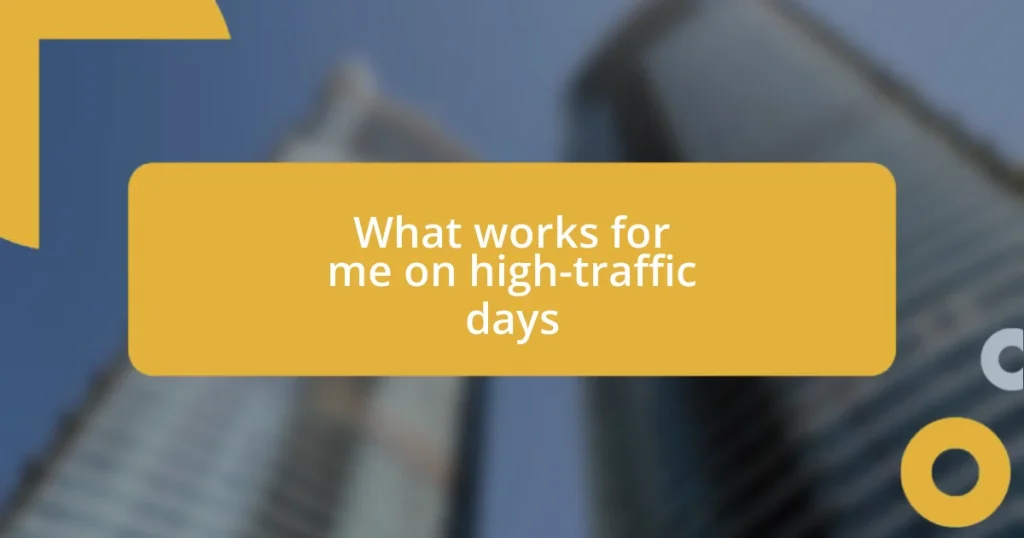Key takeaways:
- Understanding high-traffic days involves recognizing patterns, preparing resources, and maintaining emotional resilience to manage stress effectively.
- Effective time management strategies include prioritizing tasks, setting clear goals, time blocking, and utilizing productivity tools to streamline workflow.
- Post-high-traffic evaluations help identify areas for improvement and track performance metrics, fostering growth and enhancing teamwork for future challenges.

Understanding high-traffic days
High-traffic days can feel like a whirlwind, can’t they? I still remember my first experience during a busy holiday season—emails flooded in, phone calls never ceased, and I felt both exhilarated and overwhelmed. It made me realize that understanding these days is essential; they aren’t just higher volumes of work but carry unique dynamics that require our attention and strategy.
When I think about what contributes to high-traffic days, it’s often linked to specific events or seasons—think holidays, product launches, or major promotions. It’s crucial to anticipate these peaks and plan accordingly. Have you ever noticed how some days seem to buzz more than others? That’s the moment when knowing your patterns can help reduce some of the chaos.
I also find that emotional resilience plays a significant role on these days. The pressure can be intense, and I’ve had to learn to ground myself and maintain my focus amid the noise. Have you ever caught yourself just wishing it would all slow down? Understanding your response to high-traffic days can transform anxiety into productivity. This self-awareness allows me to navigate these busy times more effectively, turning potential stress into an opportunity for growth.

Preparing for increased demand
When preparing for increased demand, I often start by assessing my resources. In the past, I’ve overlooked how vital it is to have everything organized ahead of time. There was a time when I faced a sudden spike in customer inquiries. I was scrambling to find materials and clear my schedule. Now, I ensure I have extra inventory and staff available during anticipated high-traffic events, which allows me to manage the influx smoothly.
Another effective strategy is to communicate early and often. I remember when I announced an upcoming sale a week in advance. The buzz built momentum, and by the time the day arrived, I was well-prepared for the deluge of interest. This proactive communication not only pumps up customer engagement but also helps set realistic expectations for delivery times and service availability.
Lastly, I prioritize self-care during these times. There were moments when I neglected my well-being, and it quickly became unsustainable. Now, I make it a point to carve out breaks amidst the chaos to recharge. This approach keeps me energetic and positive, reinforcing my ability to serve customers efficiently while managing daily stressors.
| Strategy | Benefits |
|---|---|
| Assess Resources | Ensures preparedness and efficiency |
| Early Communication | Increases engagement and sets expectations |
| Prioritize Self-Care | Maintains energy and reduces stress |

Strategies for effective time management
One of the most effective strategies I use is prioritizing my tasks based on urgency and importance. I often create a list at the start of a high-traffic day, marking my top three ‘must-dos.’ There’s something incredibly satisfying about crossing off items from a list, especially when the demands are high.
Here are some practical approaches to enhance time management:
- Set Clear Goals: Define what you want to achieve for the day. This gives your work direction and boosts focus.
- Time Blocking: I block out specific blocks of time for particular tasks, which minimizes multitasking and maximizes productivity.
- Use Tools: I rely on apps like Trello or Asana to keep my tasks organized. They help track my progress and remind me of deadlines.
- Delegate When Possible: I’ve learned that sharing the load can relieve pressure. Relying on my team not only fosters collaboration but also lets me focus on strategic tasks.
Taking a moment to assess how I feel about my workload during these high-pressure scenarios is also crucial. I remember a particularly hectic day where I had too many moving parts and deadlines clashing. Pausing to breathe and recenter myself made a world of difference; it allowed me to reclaim control amidst the storm. Feeling grounded boosts my confidence and helps prevent burnout. Trust me, it’s an essential step I encourage everyone to adopt.
This contract between our tasks and emotional state is pivotal. Managing time effectively during high-traffic days isn’t just about schedules—it’s about making sure we’re mentally prepared to tackle what comes our way.

Prioritizing tasks for efficiency
When high-traffic days loom on the horizon, I’ve found that pinpointing which tasks to tackle first is essential for smooth sailing. For instance, I remember a busy holiday rush when I spent too long on less impactful tasks, leaving crucial responsibilities unfinished. Now, I make it a habit to rank my to-do list using a simple method: if a task advances my goals significantly or meets a deadline, it goes to the top. This clarity not only boosts my efficiency but also helps me feel accomplished when I can check them off.
Additionally, breaking larger projects into smaller, manageable parts aids in maintaining a sense of control. I’ve experienced that overwhelming feeling when faced with a huge order all at once. By dividing it into phases—like processing, packaging, and dispatching—I find my focus improves dramatically. Have you ever noticed how completing a small part of a project can energize you for the next? It’s truly a game changer. These bite-sized achievements remind me that progress is being made, even on the busiest days.
Moreover, I have begun to incorporate ‘buffer time’ between tasks. Initially, this felt indulgent, almost like I was wasting precious minutes. However, I quickly learned that taking a short break revitalizes my focus and prevents burnout. Reflecting on a chaotic day where rushing from one task to the next left me frazzled, I realized that those extra moments to breathe would have made a world of difference. Now, I view this buffer as a necessary tool for maintaining my efficiency, allowing me to return with renewed energy and clarity.

Utilizing tools for productivity
Utilizing the right tools can significantly transform how we handle productivity, especially on high-traffic days. I often turn to digital planners and task management apps, which streamline my workflow and keep my day organized. For example, during a particularly whirlwind week filled with client deadlines, using a tool like Todoist allowed me to visualize my tasks in one glance. I could rearrange priorities on the fly, tailoring my efforts to each moment’s demands. Have you ever tried such tools? If not, you might be amazed at how they can simplify even the busiest of schedules.
One standout app in my arsenal is Google Calendar. I rely on it to create reminders for all essential tasks and deadlines. When my schedule fills up, I color-code different responsibilities, visually separating personal and work commitments. Recently, I had a day where I was juggling multiple appointments, and the alerts helped me remain focused. It felt like having a trusted assistant rather than simply a calendar. Isn’t it comforting to have that level of organization in chaotic times? Trust me, it’s worth the learning curve.
Lastly, don’t underestimate the power of automation tools. I’ve implemented platforms like Zapier to handle repetitive tasks, freeing up precious time for more creative and strategic work. Initially, I was hesitant, thinking I’d lose control over my tasks. But after a week or two of integrating automation, I realized that I was not only more productive, but I also had space to explore ideas rather than being bogged down by mundane chores. How does that sound for a productivity boost? Embracing these tools truly helps me create a better balance, leading to less stress and more accomplishments on those hectic days.

Evaluating performance after high-traffic days
After a high-traffic day, I always set aside time to evaluate my performance. I like to sift through what went smoothly versus what could have been improved. One particular instance comes to mind: during an overwhelmingly busy launch day, I felt a mix of exhilaration and exhaustion. Reflecting afterward, I acknowledged that while I met my deadlines, I could’ve better managed my time between tasks. It’s this kind of reflection that shapes my future strategies.
I also find it helpful to track metrics that matter most to my goals. Last month, I started keeping a simple log of how many tasks I completed versus how many I planned. Surprisingly, I discovered I often overestimated what I could achieve and underestimated the complexity of some tasks. Have you ever felt that way? It can be enlightening to confront those gaps—it reminds me to set realistic expectations for future high-stress days.
Another aspect of my evaluation process is gathering feedback from colleagues. I remember a busy day filled with collaborative projects where we faced several hurdles. By discussing what worked and what didn’t, we were able to create a more cohesive approach for next time. Isn’t it amazing how just a simple conversation can unlock new ideas? This sharing not only strengthens teamwork but also ensures everyone learns from the chaos. Evaluating performance, it turns out, is not just about numbers; it’s a valuable opportunity for growth.















